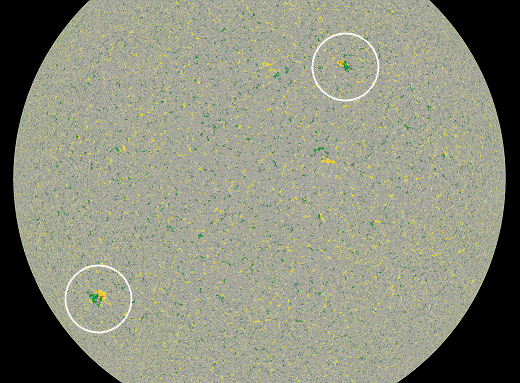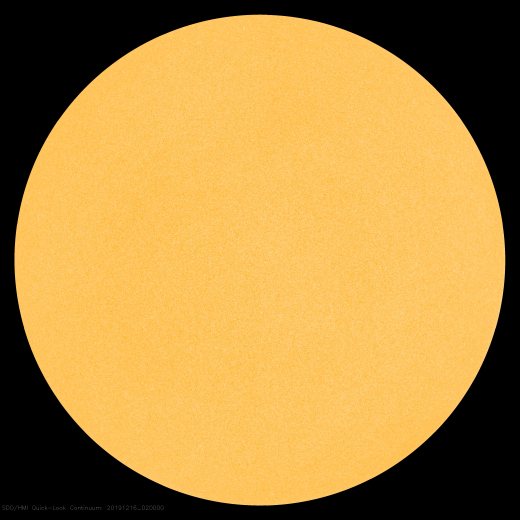Guest post by Paul Dorian
 Daily observations of the number of sunspots since 1 January 1900 according to Solar Influences Data Analysis Center (SIDC). The thin blue line indicates the daily sunspot number, while the dark blue line indicates the running annual average. The recent low sunspot activity is clearly reflected in the recent low values for the total solar irradiance. Data source: WDC-SILSO, Royal Observatory of Belgium, Brussels. Last day shown: 31 October 2019. Last diagram update: 1 November 2019. [Courtesy climate4you.com]
Daily observations of the number of sunspots since 1 January 1900 according to Solar Influences Data Analysis Center (SIDC). The thin blue line indicates the daily sunspot number, while the dark blue line indicates the running annual average. The recent low sunspot activity is clearly reflected in the recent low values for the total solar irradiance. Data source: WDC-SILSO, Royal Observatory of Belgium, Brussels. Last day shown: 31 October 2019. Last diagram update: 1 November 2019. [Courtesy climate4you.com]
*Deep solar minimum on the verge of an historic milestone*
Overview
The sun is currently in the midst of a deep solar minimum and it is about to reach an historic milestone. So far this year the sun has been blank (i.e., no visible sunspots) for 266 days and, barring any major surprises, it’ll reach 269 days early next week which will be the quietest year in terms of sunspots since 1913 when the sun was spotless for 311 days. In fact, the current stretch of consecutive spotless days has reached 29 and for the year the sun has been blank 77% of the time. The current record-holder in the satellite era for spotless days in a given year is 2008 when the sun was blank for 268 days making the 2008-2009 solar minimum the deepest since 1913.
Solar minimum is a normal part of the 11-year sunspot cycle, but the last one and the current one have been far deeper than most. One of the consequences of a solar minimum is a reduction of solar storms and another is the intensification of cosmic rays. The just ended solar cycle 24 turned out to be one of the weakest in more than a century – continuing a weakening trend that began in the 1980’s – and, if the latest forecasts are correct, the next solar cycle will be the weakest in more than 200 years.
 The sun remains spotless today and has been so 77% of the time in 2019; image courtesy NASA SDO/HMI, spaceweather.com
The sun remains spotless today and has been so 77% of the time in 2019; image courtesy NASA SDO/HMI, spaceweather.com
Solar minimum and the intensification of cosmic rays
One of the natural impacts of decreasing solar activity is the weakening of the ambient solar wind and its magnetic field which, in turn, allows more and more cosmic rays to penetrate the solar system. Galactic cosmic rays are high-energy particles originating from outside the solar system that can impact the Earth’s atmosphere. Our first line of defense from cosmic rays comes from the sun as its magnetic field and the solar wind combine to create a ‘shield’ that fends off cosmic rays attempting to enter the solar system. The shielding action of the sun is strongest during solar maximum and weakest during solar minimum with the weakening magnetic field and solar wind. The intensity of cosmic rays varies globally by about 15% over a solar cycle because of changes in the strength of the solar wind, which carries a weak magnetic field into the heliosphere, partially shielding Earth from low-energy galactic charged particles.
 Cosmic rays have been intensifying for more than 4 years. On Dec. 5th and 6th they surged within a percentage point of the Space Age record, according to data from neutron counters at the University of Oulu’s Cosmic Ray Station in Finland. Courtesy spaceweather.com.
Cosmic rays have been intensifying for more than 4 years. On Dec. 5th and 6th they surged within a percentage point of the Space Age record, according to data from neutron counters at the University of Oulu’s Cosmic Ray Station in Finland. Courtesy spaceweather.com.
High-altitude balloons have been launched on a periodic basis in recent years to monitor stratospheric radiation associated with the influx of cosmic rays and they have shown a steady increase since 2015 (campaign sponsored by spaceweather.com). In this set of measurements, cosmic rays have increased by about 13% during the past four years over the central part of California. At another location, the neutron monitor at the University of Oulu’s cosmic ray station in Finland recorded levels earlier this month that were within a percentage point of the satellite era record.
 Cosmic rays in the stratosphere are intensifying for the 4th year in a row. This finding comes from a campaign of almost weekly high-altitude balloon launches conducted by the students of Earth to Sky Calculus. Since March 2015, there has been a ~13% increase in X-rays and gamma-rays over central California, where the students have launched hundreds of balloons. The grey points in the graph are Earth to Sky balloon data. Overlaid on that time series is a record of neutron monitor data from the Sodankyla Geophysical Observatoryin Oulu, Finland. The correlation between the two data sets is impressive, especially considering their wide geographic separation and differing methodologies. Neutron monitors have long been considered a “gold standard” for monitoring cosmic rays on Earth. This shows that our student-built balloons are gathering data of similar quality.
Cosmic rays in the stratosphere are intensifying for the 4th year in a row. This finding comes from a campaign of almost weekly high-altitude balloon launches conducted by the students of Earth to Sky Calculus. Since March 2015, there has been a ~13% increase in X-rays and gamma-rays over central California, where the students have launched hundreds of balloons. The grey points in the graph are Earth to Sky balloon data. Overlaid on that time series is a record of neutron monitor data from the Sodankyla Geophysical Observatoryin Oulu, Finland. The correlation between the two data sets is impressive, especially considering their wide geographic separation and differing methodologies. Neutron monitors have long been considered a “gold standard” for monitoring cosmic rays on Earth. This shows that our student-built balloons are gathering data of similar quality.
Cosmic rays are of interest to anyone who flies on airplanes. According to spaceweather.com, the International Commission on Radiological Protection has classified pilots as occupational radiation workers because of cosmic ray doses they receive while flying. A recent study by researchers at the Harvard School of Public Health shows that flight attendants face an elevated risk of cancer compared to members of the general population. They listed cosmic rays as one of several risk factors. There are also some studies that suggest cosmic rays promote the formation of clouds in the atmosphere; if so, increasing cosmic rays could affect weather and climate.
 400 years of sunspot observations; courtesy Wikipedia
400 years of sunspot observations; courtesy Wikipedia
Solar cycle 25
The solar cycle is like a pendulum, swinging back and forth between periods of high and low sunspot number every 11 years or so. Researchers have been tracking solar cycles since they were discovered in the 19th century. The just ended solar cycle, #24, was the weakest with the fewest sunspots since solar cycle 14 peaked in February 1906. Solar cycle 24 continued a recent trend of weakening solar cycles which began with solar cycle 21 that peaked around 1980. The very latest forecast for the next solar cycle (#25) says it will be weaker than the just ended SC24 and perhaps the weakest of the last 200 years. To be fair, some earlier forecasts had the next solar cycle being in similar magnitude to SC24. However, research now underway has apparently found a more reliable method to predict space weather. The maximum of this next cycle – measured in terms of sunspot numbers, could be 30 to 50% lower than the most recent one – solar cycle 24 according to the latest forecast. The results of this new forecasting technique show that the next solar cycle will start in 2020 and reach its maximum in 2025.
The new forecast is the work of a team led by Irina Kitiashvili of the Bay Area Environmental Research Institute at NASA’s Ames Research Center in Silicon Valley, California. Using data collected since 1976 from the Solar and Heliospheric Observatory and the Solar Dynamics Observatory space missions, the researchers were able to come up with a prediction by directly observing the solar magnetic field rather than simply counting sunspots, which provides only a rough gauge of activity inside the Sun. Because this is a relatively new approach, there is only data from four complete cycles, but by combining three sources of solar observations with estimates of the Sun’s interior activity, the team was able to produce a prediction in 2008 that matched the activity that was observed over the past 11 years.
One challenge for researchers working to predict the Sun’s activities is that scientists do not yet completely understand the inner workings of our star. Some factors that play out deep inside the Sun cannot be measured directly. They have to be estimated from measurements of related phenomena on the solar surface like sunspots, coronal holes and filaments. Kitiashvili’s method differs from other prediction tools in terms of the raw material for its forecast. Previously, researchers used the number of sunspots to represent indirectly the activity of the solar magnetic field. The new approach takes advantage of direct observations of magnetic fields emerging on the surface of the Sun.
 Temperature recordings at the Greenland Ranch weather station in Death Valley, California during the intense heat wave of July 1913. This excerpt about the record-breaking heat wave comes from an article posted during January 1922 in the meteorological journal Monthly Weather Review which is still in publication today. Courtesy NOAA
Temperature recordings at the Greenland Ranch weather station in Death Valley, California during the intense heat wave of July 1913. This excerpt about the record-breaking heat wave comes from an article posted during January 1922 in the meteorological journal Monthly Weather Review which is still in publication today. Courtesy NOAA
Extreme weather of 1913
One final note of interest, the year 1913 cited earlier for its lack of sunspots on the order of 311 days was a year filled with wild weather extremes including the hottest temperature ever recorded on Earth in Death Valley, CA. For more on the extreme weather of 1913 click here.
Meteorologist Paul Dorian
Perspecta, Inc.
perspectaweather.com







 Figure 5: Solar hemispheric sunspot area and F10.7 flux 1985 – 2019
Figure 5: Solar hemispheric sunspot area and F10.7 flux 1985 – 2019




 Daily observations of the number of sunspots since 1 January 1900 according to
Daily observations of the number of sunspots since 1 January 1900 according to  The sun remains spotless today and has been so 77% of the time in 2019; image courtesy NASA SDO/HMI, spaceweather.com
The sun remains spotless today and has been so 77% of the time in 2019; image courtesy NASA SDO/HMI, spaceweather.com Cosmic rays have been intensifying for
Cosmic rays have been intensifying for  Cosmic rays in the stratosphere are intensifying for the 4th year in a row. This finding comes from a campaign of almost weekly high-altitude balloon launches conducted by the students of Earth to Sky Calculus. Since March 2015, there has been a ~13% increase in X-rays and gamma-rays over central California, where the students have launched hundreds of balloons. The grey points in the graph are Earth to Sky balloon data. Overlaid on that time series is a record of neutron monitor data from the
Cosmic rays in the stratosphere are intensifying for the 4th year in a row. This finding comes from a campaign of almost weekly high-altitude balloon launches conducted by the students of Earth to Sky Calculus. Since March 2015, there has been a ~13% increase in X-rays and gamma-rays over central California, where the students have launched hundreds of balloons. The grey points in the graph are Earth to Sky balloon data. Overlaid on that time series is a record of neutron monitor data from the  400 years of sunspot observations; courtesy Wikipedia
400 years of sunspot observations; courtesy Wikipedia Temperature recordings at the Greenland Ranch weather station in Death Valley, California during the intense heat wave of July 1913. This excerpt about the record-breaking heat wave comes from an article posted during January 1922 in the meteorological journal Monthly Weather Review which is still in publication today. Courtesy NOAA
Temperature recordings at the Greenland Ranch weather station in Death Valley, California during the intense heat wave of July 1913. This excerpt about the record-breaking heat wave comes from an article posted during January 1922 in the meteorological journal Monthly Weather Review which is still in publication today. Courtesy NOAA
